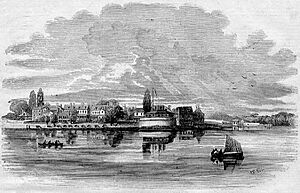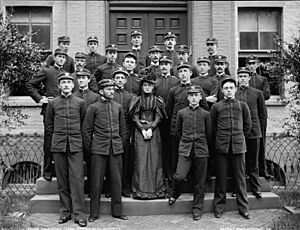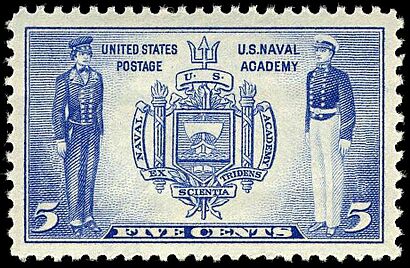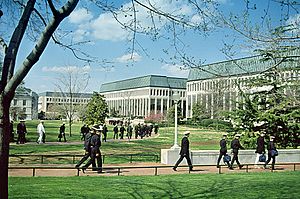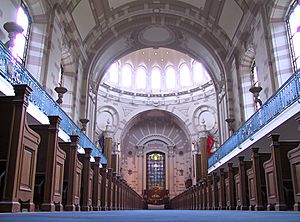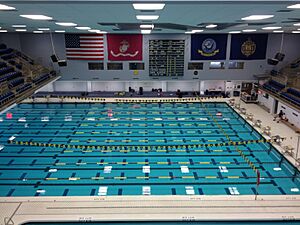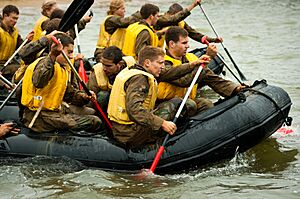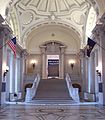United States Naval Academy facts for kids
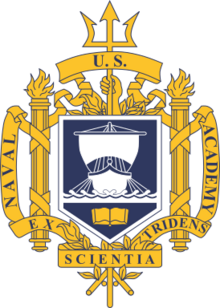 |
|
| Motto | Ex Scientia Tridens (Latin) |
|---|---|
|
Motto in English
|
From Knowledge, Seapower |
| Type | U.S. service academy |
| Established | 10 October 1845 |
|
Parent institution
|
Naval University System |
|
Academic affiliations
|
Space-grant |
| Superintendent | Vice Admiral Yvette M. Davids |
| Provost | Samara L. Firebaugh |
| Commandant of Midshipmen | Captain Gilbert E. Clark, Jr. |
|
Academic staff
|
510 |
| Students | 4,576 |
| Location |
,
United States
|
| Campus | Urban – 338 acres (1,370,000 m2) |
| Colors | Navy Blue Gold |
| Nickname | Midshipmen |
|
Sporting affiliations
|
|
 |
|
|
U.S. Naval Academy
|
|
| Lua error in Module:Location_map at line 420: attempt to index field 'wikibase' (a nil value). | |
| Location | Maryland Avenue and Hanover Street, Annapolis, Maryland |
| Built | 1845 |
| Architect | Ernest Flagg |
| Engineer | Severud Associates |
| Architectural style | Beaux Arts |
| NRHP reference No. | 66000386 |
| Significant dates | |
| Added to NRHP | 15 October 1966 |
| Designated NHLD | 4 July 1961 |
The United States Naval Academy (USNA, Navy, or Annapolis) is a special school for future officers in the United States Navy and United States Marine Corps. It is located in Annapolis, Maryland. The academy was started on October 10, 1845, by George Bancroft, who was the Secretary of the Navy at the time. It is the second oldest of the five U.S. service academies.
The campus is about 338 acres and is built on the old grounds of Fort Severn. It sits where the Severn River meets the Chesapeake Bay. The whole campus, often called "the Yard," is a National Historic Landmark. It has many important historical places, buildings, and monuments.
Students who want to join the academy usually need to apply directly and also get a nomination, often from a member of Congress. Students are called "midshipmen" and are training to be officers. The Navy pays for their education completely. In return, they agree to serve in the military after they graduate.
About 1,200 new students, called "plebes," start at the academy each summer. They go through a tough training period called Plebe Summer. Around 1,000 midshipmen graduate each year. After graduating, they become ensigns in the Navy or second lieutenants in the Marine Corps. Some can also join other U.S. military branches or even the forces of allied countries. The Naval Academy offers a Bachelor of Science degree. Students are graded on their studies, leadership skills, and required participation in sports. Midshipmen must follow the academy's Honor Concept.
Contents
The Navy also has other schools like the Naval Postgraduate School and the Naval War College. The Naval Academy Preparatory School (NAPS) in Newport, Rhode Island, helps students get ready for the Naval Academy.
History
The idea for a school for naval officers began in 1819. The first "Nautical School" opened on a ship called the USS Guerriere in 1821. It taught midshipmen about naval tactics, astronomy, and other subjects. This small school eventually led to the U.S. Naval Academy in Annapolis.
The academy's history can be divided into four main periods. These include its early years at Fort Severn, the time after the Civil War, the "Flagg Academy" period, and the modern era since 1941.
The academy's Latin motto is Ex Scientia Tridens. This means 'Through Knowledge, Sea Power'.
Early Years
The Naval School was officially founded on October 10, 1845, by Secretary of the Navy George Bancroft. It was set up at Annapolis on the land of the old U.S. Army post Fort Severn. The school started with 50 midshipman students and seven teachers. The decision to build a school on land may have been partly due to an event on the USS Somers. This event involved an alleged mutiny and an execution at sea.
At first, students studied for five years. Only the first and last years were spent at the school. The other three years were spent at sea. The school changed its name to the United States Naval Academy in 1850. The study program was extended to seven years, with four years at the school and three years at sea. In 1851, all four years of study were made continuous. Practice cruises replaced the three years at sea. The first class of naval academy students graduated on June 10, 1854.
In 1860, the Tripoli Monument was moved to the academy grounds. Later that year, the USS Constitution, a famous old ship, became a school ship for first-year midshipmen. They lived on board to learn about life at sea.
American Civil War
The American Civil War caused big changes for the Naval Academy. Many people in Maryland supported the Southern states. The academy had to move quickly to Fort Adams in Newport, Rhode Island in April 1861. The USS Constitution helped transport the academy. The Annapolis campus became a U.S. Army Hospital.
Many officers, including 95 graduates and 59 midshipmen, left the U.S. Navy to join the Confederate States Navy. The first superintendent, Admiral Franklin Buchanan, became the first admiral of the Confederate Navy.
The midshipmen and teachers returned to Annapolis in the summer of 1865, right after the war ended.
After the Civil War
After the Civil War, Admiral David Dixon Porter became the superintendent in 1865. He worked to rebuild the academy, which was in bad shape. He focused on hiring naval officers as teachers instead of civilians. He also started organized sports for students.
In 1868, a famous figurehead of Tamanend (later called "Tecumseh") was placed in the Yard. Class rings were first given out in 1869. Porter also bought more land for the academy to grow.
In the 1870s, military budget cuts meant fewer students graduated. Congress passed a law against hazing in 1874, though it continued in secret ways.
The academy saw some important firsts for minority students. In 1877, Kiro Kunitomo, from Japan, graduated. In 1879, Robert F. Lopez was the first Hispanic-American to graduate. John H. Conyers was the first African-American admitted in 1872, but he faced severe mistreatment and left the academy in 1873.
In 1890, Navy adopted the goat mascot after winning its first football game against Army.
The Flagg Academy: Early 1900s
The Spanish–American War in 1898 made the academy even more important. Most of the campus was rebuilt and made much larger between 1899 and 1906. The land was made stronger with deep pilings to support the new, heavy stone buildings. Today's campus mostly dates from this time.
In 1910, the academy started its own dairy farm. This farm was also home to Bill the Goat, the mascot. The dairy closed in 1998.
The Aviation School
In 1911, the Navy started an aviation school at Greenbury Point, Annapolis. It had a building with three hangars for new airplanes, a workshop, and offices. The planes cost $14,000 in total. Many officers wanted to learn to fly. Students had to pass a swimming test and other qualifications. The Navy flight training later moved to NAS Pensacola, Florida, in 1914.
By 1912, the midshipmen were organized into a "brigade," which is how they are structured today. During World War I, the number of students and teachers tripled. The academy also built more parts of Bancroft Hall. In 1918, the Spanish flu pandemic affected about half the students, and ten midshipmen died.
World War I and Between Wars
After World War I, the academy became a popular place for tourists.
In 1920, the Naval Academy's men's rowing team won a gold medal at the Olympics in Brussels. U.S. college rowing teams continued to win gold medals in this event for the next seven Olympics.
The Navy football team played in the Rose Bowl Game in 1924, tying 14–14. In 1926, Navy won the national college football championship. In 1926, the academy's alma mater song, "Navy Blue and Gold," was first sung in public. It became a tradition to sing it at the end of student and alumni gatherings.
In 1929, graduates were allowed to apply for Rhodes Scholarships. Six graduates received this honor that same year. The academy's courses were officially recognized by the Association of American Universities in 1930.
In 1933, a law was passed allowing the Naval Academy to award a Bachelor of Science degree. The Class of 1933 was the first to receive this degree. Four years later, all living graduates were also given this degree.
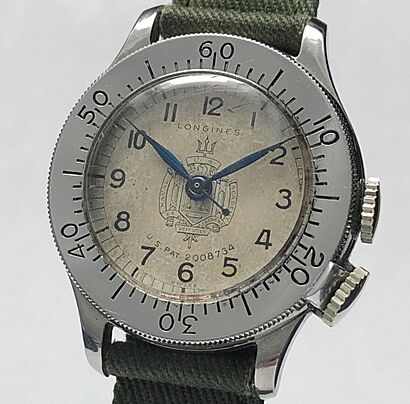
In 1940, the academy stopped using the ship Reina Mercedes as a place to discipline midshipmen. In 1941, more parts of Bancroft Hall were finished.
Modern Era: World War II to Present
During World War II, 3,319 graduates became officers. In 1943, the first SCUBA diving course in the U.S. was held at the academy. In 1945, a Department of Aviation was created. The academy celebrated its 100th anniversary. By then, about 18,563 midshipmen had graduated.
The academy was officially recognized by the Middle States Commission on Higher Education in 1947. In 1947, James L. Holloway Jr. became the youngest superintendent in 50 years. He was chosen to make the academy's education more focused on general learning and less on strict military details.
On June 3, 1949, Wesley A. Brown became the first African-American to graduate from the academy. Later, Lawrence Chambers became the first African-American graduate to become an admiral.
The Navy fencing team won the NCAA national championship in 1950. The Navy rowing team won a gold medal at the 1952 Summer Olympics in Helsinki, Finland. In 1955, the tradition of greasing Herndon Monument began. First-year students (plebes) climb it to swap their "dixie cup" hats for a midshipman's hat.
The 1959 fencing team won another NCAA national championship. The Navy–Marine Corps Memorial Stadium was opened in 1959.
From 1959 to 1973, more land was created from the Chesapeake Bay and Severn River. This allowed for more buildings and sports fields.
Joe Bellino (Class of 1961) won the Heisman Trophy in 1960. In 1961, the Naval Academy Foreign Affairs Conference started. The U.S. Naval Academy campus was named a National Historic Landmark in 1961. The 1962 fencing team won another NCAA national championship. In 1963, Roger Staubach (Class of 1965) also won the Heisman Trophy.
In 1963, the academy changed its grading system to letter grades. The statue of Tamanend became known as the "god of 2.0," which is the minimum passing grade.
Professor Samuel Massie became the first African-American faculty member in 1966. In 1969, the first specific engineering degrees were given out. Between 1968 and 1972, the academy offered more than 20 different majors. In 1970, the "James Forrestal Lecture" series began, bringing important leaders to speak to midshipmen.
In 1972, Lieutenant Commander Georgia Clark became the first female officer instructor. Dr. Rae Jean Goodman was the first civilian woman appointed to the faculty. Also in 1972, students were no longer required to attend chapel. In 1973, the new library was finished and named for Fleet Admiral Chester W. Nimitz.
On August 8, 1975, Congress allowed women to attend service academies. The Class of 1980 included 81 female midshipmen. In 1980, Elizabeth Anne Belzer became the first woman to graduate. Janie L. Mines became the first African-American woman graduate. In 1984, Kristine Holderied was the first woman to graduate at the top of her class.
In 1982, some older halls were taken down. In 1987, the Computer Science program received official recognition. In 1991, Midshipman Juliane Gallina became the first woman brigade commander. In 1994, job assignments for graduates became gender-neutral, meaning men and women could apply for almost all roles.
On March 12, 1995, Lieutenant Commander Wendy B. Lawrence, a graduate from the Class of 1981, became the first woman USNA graduate to fly in space.
To celebrate the academy's 150th anniversary, the United States Postal Service released a special postage stamp in 1995.
The Freedom 7 space capsule, America's first into space in 1961, was put on display at the visitor center in 1998. It honored Rear Admiral Alan Shepard, a Class of 1945 graduate, who flew it.
On September 11, 2001, the academy lost 14 alumni in the September 11 attacks. The campus was placed under very high security.
In August 2007, Superintendent Vice Admiral Jeffrey Fowler changed academy rules to emphasize teamwork and the fact that the nation was at war.
On November 3, 2007, the Navy football team beat Notre Dame for the first time in 43 years. The two teams have played every year since 1926. Notre Dame helped the Navy by letting them train officers on their campus during World War II.
In November 2007, Memorial Hall hosted the Annapolis Conference for peace discussions between Palestinians and Israelis.
In 2017, hospital services moved to a new location across the Severn River.
In 2019, the USNA rowing team represented the U.S. in the King's Cup at the Henley Royal Regatta. They won the final race against the German team.
In 2024, the academy withdrew an invitation for a scholar to give a lecture due to outside pressure.
Training Ships
| Academy training ships, 1850–1957 |
|---|
|
Student Ranks
The students at the Naval Academy are called the Brigade of Midshipmen. They are appointed as midshipmen and are considered officers-in-training. They rank just below chief warrant officers.
Midshipmen are not called freshmen, sophomores, juniors, and seniors. Instead, they are called:
- Fourth Class: These are the first-year students, also known as "plebes." They have many rules and tasks that their older classmates do not. This year helps them change from civilians into military officers.
- Third Class: These students are called "youngsters." They are more integrated into the academy and have more privileges, like watching TV or listening to music.
- Second Class: These midshipmen are in charge of training the plebes. They report to the first class and can give orders. They are allowed to drive their own cars (but not park them on campus) and wear regular clothes on weekends.
- First Class: These are the senior students, called "firsties." They have the most freedom and are responsible for leading the entire brigade. They can park their cars on campus and have more time off.
The brigade is divided into two groups called regiments, each with three battalions. Each battalion has six companies, making a total of 36 companies. The student leader of the entire brigade is a first-class midshipman called the brigade commander. This person is chosen for their excellent leadership. The brigade commander manages many daily activities and the training of midshipmen. An active-duty Navy captain or Marine Corps colonel, called the commandant of midshipmen, oversees all brigade activities.
Insignia
| Rank group | Senior officers | Junior officers | ||||
|---|---|---|---|---|---|---|
 |
 |
 |
 |
 |
 |
|
| Midshipman captain | Midshipman commander | Midshipman lieutenant commander | Midshipman lieutenant | Midshipman lieutenant (junior grade) | Midshipman ensign | |
| Rank group | ||||
|---|---|---|---|---|
 |
 |
 |
 |
|
| Midshipman first class | Midshipman second class | Midshipman third class | Midshipman fourth class | |
Uniforms
Midshipmen wear uniforms similar to U.S. Navy officers. Their shoulder boards and sleeve badges show their school year or midshipman officer rank. All wear gold anchor badges on their service dress blue jacket collars.
On their working blue uniform shirts, first-year students (plebes) wear no collar badges. Second-year students (youngsters) wear one anchor. Third-year students wear anchors on both collars. Senior students (firsties) wear anchors with eagles. First-class midshipmen in leadership roles wear gold bars to show their rank.
Midshipmen wear Summer White or Service Dress Blue uniforms for formal events. They wear Working Blue for daily classes. During special times, like "Tactical Thursdays," senior midshipmen might wear uniforms related to their future jobs, like flight suits or camouflage. A unique blue uniform with a double-breasted jacket is worn for formal parades.
Campus
The campus, or "Yard," has grown a lot since 1845. It started as a 40,000 square meter Army post and is now about 1.37 square kilometers.
Halls and Main Buildings
- Bancroft Hall is the largest building at the Naval Academy. It is also the largest college dormitory in the world. All midshipmen live there. Visitors can see Memorial Hall, which honors graduates who died in military operations, and the Rotunda, the main entrance.
- The Naval Academy Chapel is in the center of campus. Its tall dome can be seen from all over Annapolis. It was featured on a U.S. postage stamp in 1995. The famous naval hero John Paul Jones is buried in the crypt beneath the chapel.
- The Commodore Uriah P. Levy Center and Jewish Chapel was opened in 2005. It has a Jewish chapel, ethics learning areas, and offices. Its outside design matches nearby Bancroft Hall.
- Alumni Hall is where all midshipmen gather. It has two dining areas and hosts sports events, including basketball games. The Bob Hope Performing Arts Center is also located here.
- Halsey Field House has an indoor track, courts for squash and tennis, basketball courts, a martial arts room, a climbing wall, and other sports facilities.
- Hubbard Hall, also called the Boat House, is used by the crew team. It is located on Dorsey Creek, near the Severn River.
- Lejeune Hall, built in 1982, has an Olympic-sized swimming pool, a diving tower, and a mat room for wrestling. It also houses the Athletic Hall of Fame.
- Wesley Brown Field House is used for physical education, sports, and fitness. It has a retractable football field, a 200-meter track, and basketball courts. It is named for Wesley A. Brown, the academy's first African American graduate.
Monuments and Memorials
- Gokoku-ji Bell: This bell is a copy of an original bell brought from Japan in 1855. It is rung for every Navy victory over Army.
- Enterprise Bell: This ship's bell from the USS Enterprise (CV-6) is rung when Navy beats Army in certain sports.
- USS Delaware figurehead: This bronze statue is a replica of a figurehead from an old ship. It is often called Tecumseh. Students used to throw pennies at it for good luck, especially before sports games against West Point or for exams. It is also called the God of 2.0 because 2.0 is the lowest passing GPA.
- Battle ensigns: Famous U.S. Navy flags and captured enemy flags are displayed. One famous flag is the "Don't Give Up the Ship" flag from the Battle of Lake Erie.
- Herndon Monument: This monument honors Commander William Lewis Herndon, who died saving his ship in a hurricane in 1857. It was put in its current spot in 1860 and has never moved.
- Memorial Hall: Located in Bancroft Hall, this hall honors graduates who died in military operations.
- Pearl Harbor Memorial: A wall in Alumni Hall remembers those killed in the attack on Pearl Harbor.
- Tripoli Monument: This is the oldest military monument in the U.S. It honors servicemen from the First Barbary War. It was carved in Italy in 1806 and moved to the academy in 1860.
- USS Samuel B. Roberts memorial: In Alumni Hall, a section honors Lieutenant Lloyd Garnett and his shipmates from the USS Samuel B. Roberts.
- The Mexican War Midshipmen's Monument: This monument remembers midshipmen who died in the Mexican–American War.
- The Macedonian Monument: This is the figurehead from the HMS Macedonian, a British ship captured by the USS United States in 1812.
- The Saitö Monument: This Japanese granite pagoda honors Hiroshi Saitö, a Japanese Ambassador to the U.S. It was put up in 1941.
Brigade Sports Complex
This complex includes the McMullen Hockey Arena, rugby fields, a golf practice facility, and the Tose Family Tennis Center.
Cemetery and Columbarium
The academy has its own cemetery.
Glenn Warner Soccer Facility
This is where the soccer team plays.
This stadium is used for football and other events.
Terwilliger Brothers Field
The academy baseball team plays at the Terwilliger Brothers Field at Max Bishop Stadium.
Sea Level Rise and Flooding
In recent years, the academy grounds have experienced more flooding. This is due to stronger storms and a rising sea level. The academy has a plan to deal with this, including building seawalls and raising building entrances. A $37 million seawall was finished in 2024.
Academy Supervision
The Naval Academy is overseen by the Chief of Naval Operations. A group called the Board of Visitors checks the academy each year. This board includes officials chosen by Congress and the president. In 2020, they suggested changing the names of buildings named after people who left the Union during the Civil War.
Faculty
The academy has about 500 teachers. Half are civilian professors, and half are military instructors. Most civilian professors have a PhD and can get permanent positions. Most military instructors have a master's degree and usually teach for two or three years.
Permanent Military Professors (PMP)
A small group of officers are permanent military professors. They all have PhDs and stay at the academy until they retire. They are usually Navy commanders or captains.
This is a special teaching position in the history department. It was created by the Class of 1957 to help students better understand naval history. A distinguished historian holds this position for one or two years.
McCain-Fulbright Distinguished Visiting Professor Program
This program brings international teachers to the academy. They teach about their home regions and share their knowledge.
How to Get In
To get into the Naval Academy, candidates usually need a nomination from a member of Congress or the Vice President. Each member of Congress can have five students attending the academy at any time. When a student graduates or leaves, a spot opens up. Congress members usually nominate about 15 people for each open spot.
The Secretary of the Navy can also appoint 170 enlisted members of the Navy and Marine Corps each year. There are also spots for children of career military personnel and children of military members who were killed, disabled, or are missing in action.
To be admitted, candidates must be between 17 and 23 years old when they start. They must be unmarried, have no children, and be of good character. The application process includes an application, essays, references, and often an interview. Candidates also take a physical fitness test and a full medical exam.
A small number of international students from allied countries are also admitted each year. For example, the Class of 2025 includes 16 international students from various countries.
Seven students from West Point, the Air Force Academy, and the Coast Guard Academy can spend a fall semester at Annapolis. Naval Academy midshipmen can also go to those academies for a semester.
Academics
The Naval Academy was recognized as a "technological institution" in 1930. In 1933, a law allowed the academy to award a Bachelor of Science degree. The Class of 1933 was the first to receive this degree. Later, the academy changed from a fixed set of courses to a core curriculum with 22 different major fields of study.
The academic departments are divided into three groups: Engineering and Weapons, Mathematics and Science, and Humanities and Social Sciences.
In 2021, U.S. News & World Report ranked the U.S. Naval Academy as the No. 1 top public school. It was also ranked No. 6 among national liberal arts colleges and No. 5 for Best Undergraduate Engineering programs at schools that do not offer doctorates.
Moral Education
Developing good character and ethics is very important at the Naval Academy. The Officer Development Program teaches midshipmen about integrity, honor, and respect. This program lasts all four years.
A main goal is for midshipmen to understand their own moral beliefs and be able to express them. Honor is stressed through the Honor Concept of the Brigade of Midshipmen, which says:
- Midshipmen are honest and stand for what is right. They tell the truth.
- They are fair in all they do. They make sure their work is their own and that any help they get is allowed and noted. They do not cheat.
- They respect other people's belongings and make sure others can use their own property. They do not steal.
Midshipmen are allowed to talk to someone they see breaking the code without formally reporting them. This is meant to help build honor and trust.
Student groups called Brigade Honor Committees teach and train others about the Honor Concept. Midshipmen who break the Honor Concept can be removed from the academy, depending on how serious the offense is.
Since 1961, the academy has hosted the annual Naval Academy Foreign Affairs Conference (NAFAC). This is the largest conference for college students interested in foreign affairs. It allows students to discuss important international issues from both civilian and military viewpoints.
Each year, a new topic is chosen for NAFAC. Important people with knowledge in those areas are invited to speak. Students from colleges across the U.S. and around the world attend.
Midshipmen organize and run the entire conference. They also act as discussion leaders and participants.
The Naval Academy Science and Engineering Conference (NASEC) is an annual science and engineering conference for college students. Held every November, about 45 midshipmen and 150 students from other colleges meet to discuss big science and engineering challenges. They hear from leaders in science and policy and join group discussions.
This conference helps midshipmen develop leadership skills and learn about new science and engineering topics.
Since 1973, the Naval Academy has hosted a major international conference for naval historians. In 2006, it was named after John J. McMullen, a graduate from the Class of 1940.
Small Satellite Program
The United States Naval Academy (USNA) Small Satellite Program (SSP) started in 1999. It allows midshipmen to design, build, test, and control small satellites that go into space.
The first satellite from this program, MidSTAR I, was launched on March 8, 2007.
Postgraduate Studies
Most graduates go directly into their military jobs, so the Naval Academy does not offer graduate degrees. However, some programs allow midshipmen to get master's degrees before they start their military service. For example, the Immediate Graduate Education Program (IGEP) lets new officers go straight to graduate school. Other programs allow students to start graduate studies in their senior year or pursue special scholarships like the Rhodes Scholarship.
Student Activities
| Race and ethnicity | Total | |
|---|---|---|
| White | 61% |
|
| Hispanic | 12% |
|
| Other | 11% |
|
| Asian | 8% |
|
| Black | 7% |
|
| Foreign national | 1% |
|
Athletics
Most midshipmen must participate in sports. If they are not on a varsity team, they must join an intramural or club sport. Some exceptions are made for activities like the YP Squadron, which provides professional training.
Varsity athletes who earn a letter wear a special blue sweater with a gold "N" patch. Teams that beat Army in a year get a gold star to add to their patch for each win.
The U.S. Naval Academy's sports teams are usually called "the Midshipmen" or "the Mids." Their mascot is a goat named "Bill."
The Midshipmen compete in the NCAA's Division I FBS for football. For most other sports, they are part of the Patriot League. The academy has 33 varsity sports teams and 15 club sports teams.
The most important sports event is the annual Army–Navy Game in football. The three main service academies (Navy, Air Force, and Army) compete for the Commander in Chief's Trophy. This trophy goes to the academy that beats the others in football that year. Keenan Reynolds, a Navy quarterback from 2012–2015, set many records and was the first quarterback to beat Army four times.
Navy sports teams have achieved many successes. In 1926, Navy's football team won the U.S. national championship. The men's lacrosse team has won many national championships. The men's fencing team won NCAA Division I championships in 1950, 1959, and 1962. The 1945 men's outdoor track and field team and the 1964 men's soccer team also won NCAA Division I championships.
The academy's lightweight rowing team won national championships in 2004 and 2021. The heavyweight rowing team won Olympic gold medals in men's eights in 1920 and 1952. In shooting, the Naval Academy has won many national rifle and pistol team trophies. Navy's squash team won national championships in 1957, 1959, and 1967. The boxing team won national championships in 1987, 1996, 1997, 1998, and 2005.
There is also an unofficial croquet team. They play against students from St. John's College, Annapolis every April in the Annapolis Cup. As of 2024, the Midshipmen have won 8 times and lost 32 times to St. John's.
Other Extra-Curricular Activities
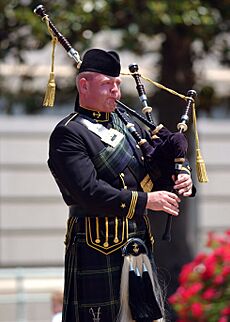
Midshipmen can join many other activities. These include musical groups like the Drum & Bugle Corps, Glee Clubs, and a Gospel Choir. There are also religious groups, academic honor societies, and a radio station (WRNV). Students can also join professional activities like diving, flying, and seamanship. The midshipman theater company, The Masqueraders, puts on one play each year. There is also a debate team that competes with other colleges. Midshipmen also take part in the Sandhurst Competition, a military skills event.
The brigade used to publish a humor magazine called The Log. It was stopped in 2001 but returned in 2008.
Songs
Two important songs are sung at the Naval Academy. "Anchors Aweigh" is the academy's fight song and is well-known throughout the U.S. Navy. It is sung at sports events and played by the Drum and Bugle Corps. "Blue and Gold" is the academy's alma mater song. It is sung at the end of sports events and alumni gatherings.
Police
The Naval Support Activity Annapolis Police Department is responsible for keeping the U.S. Naval Academy safe. It includes both civilian police and Navy Masters-at-Arms. They enforce laws and help people in need.

The Naval Academy first accepted women as midshipmen in 1976. This happened after Congress allowed women to join all service academies. Women make up about 22 percent of new students. They receive the same training as men, though some physical standards are different, just like in the Navy itself. Women have made up about 17 percent of recent graduating classes, and this number is growing. The first pregnant midshipman graduated in 2009 after receiving special permission.
In 2006, Michelle J. Howard, Class of 1982, became the first female graduate of the Naval Academy to be chosen as an admiral. Margaret D. Klein, Class of 1981, became the first female commandant of midshipmen in December 2006.
In May 2021, Vice President Kamala Harris became the first female commencement speaker at the Naval Academy.
Yvette M. Davids became the first female Superintendent of the Naval Academy on January 11, 2024.
Traditions
- Anchors Aweigh is a famous song written at the Naval Academy. It represents the entire United States Navy. Midshipman Alfred H. Miles wrote the lyrics, and 2nd Lieutenant Charles A. Zimmermann, the bandmaster, wrote the music. It is sung at sports events and played during meal formations.
- "Blue and Gold" is the Naval Academy's alma mater song. It is sung at the end of every sports event, pep rallies, and alumni gatherings. First-year students (plebes) also sing it at the end of the day during Plebe Summer.
- Herndon Monument Climb – This is a yearly tradition that marks the end of the first year for plebes. The monument is covered in lard, and the new upperclassmen work together to climb it. They replace a plebe's "dixie cup" hat with a midshipman's hat at the top. This shows their change from plebe to third-classman. In 2008, the hats used were those of Midshipman Kristen Dickmann, who had recently passed away. These were the first women's hats used for the Climb.
Notable Alumni
Many famous people have graduated from the Naval Academy. These include over 50 U.S. astronauts, with six who flew to the Moon. More astronauts have come from the Naval Academy than from any other college in the U.S. Over 990 graduates are noted scholars, including 46 Rhodes Scholars and 24 Marshall Scholars.
One U.S. President, Jimmy Carter, graduated from the academy. He also won a Nobel Prize. Albert A. Michelson, a graduate from 1873, won the Nobel Prize in Physics in 1907. 73 alumni have received the Medal of Honor, the highest military award.
- Notable graduates
-
Albert A. Michelson Class of 1873
-
Jimmy Carter
Class of 1947 -
Ross Perot
Class of 1953 -
David Maurice Robinson
Class of 1987 -
Sunita Lyn Williams
Class of 1987
Images for kids
See also
 In Spanish: Academia Naval de los Estados Unidos para niños
In Spanish: Academia Naval de los Estados Unidos para niños
- Alumni House (United States Naval Academy)
- Annapolis (2006 film)
- Hispanics in the United States Naval Academy
- Mace of Parliament of Upper Canada
- Naval Academy Bridge
- Navy Blue and Gold (film)
- Old Goat Award
- USNA Out
- United States Merchant Marine Academy


